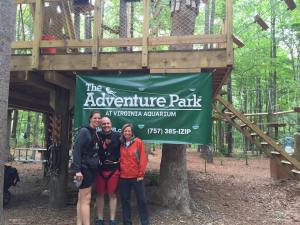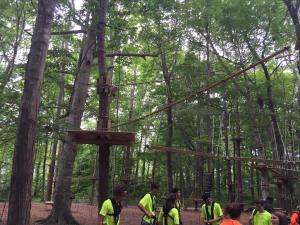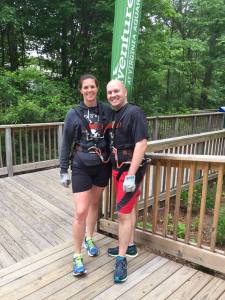 Have you ever considered how you or your presenters introduce new content to learners?
Have you ever considered how you or your presenters introduce new content to learners?
Last year I had the opportunity during a site visit with a client to partake in The Adventure Park at Virginia Aquarium. If you’re ever in the area, you absolutely have to check it out. The technology is quite remarkable within the outdoor recreation industry – and the memories, particularly if you’re new to climbing, will last a lifetime.
The Adventure Forest itself spans nearly six acres of the tree canopy. After completing a briefing on how to use the “always-locked-on” gear, guests climb into a main tree platform where they can choose from 15 different trails that are color coded to indicate the degree of challenge they offer.
Trails are marked just like ski runs, with some suitable for novice, some for intermediate and some for advanced climbers. These trails include more than 165 challenging crossings made of rope, cable and wood. Among these crossings are more than 20 zip lines. The most challenging trails are up to 55 feet above the ground.
So, picture me. While I was initially an eager student, my ego quickly deflated as I reached the very first platform. As I surveyed the challenge before me, I considered both how I would cross it and what might happen if I fell.
As an experienced outdoor professional and coach, my client immediately became a trusted friend, confidant and mentor. She encouraged and supported my active engagement, perseverance and growth – but all within the context of challenge by choice.
 Challenge by choice is an important principle in adventure-based programming. While simple in principle, challenge by choice is complex in both practice and reality. The simple principle is that participants are invited to participate voluntarily in each of the various activities and challenges. A participant may choose to sit out of an activity and this right is to be respected both by others in the group and by the instructors.
Challenge by choice is an important principle in adventure-based programming. While simple in principle, challenge by choice is complex in both practice and reality. The simple principle is that participants are invited to participate voluntarily in each of the various activities and challenges. A participant may choose to sit out of an activity and this right is to be respected both by others in the group and by the instructors.
The same should hold true of presenters:
- We should encourage and support active engagement in our sessions.
- We should invite learners to participate in each of the activities and challenges we present.
- We should respectfully permit participants to sit out of an activity or challenge.
In other words, we should introduce new content in a responsible and approachable way. After all, you wouldn’t take new climbers out on the Double Black Diamond trail in the adventure park without first developing their confidence and climbing skills on the purple and yellow trails.
For me, two major factors generally determine whether or not content is introduced responsibly: number of learners and sophistication of content.
Number of Learners
The first factor presenters should consider when introducing new content is the number of learners participating in the activity or challenge. By roughly dividing the session in thirds:
- The first third should introduce activities or challenges comprising the learner and just one other participant (i.e., pairs or neighbors).
- The second third should introduce activities or challenges comprising the learner and two or three other participants (i.e., small groups).
- The final third should introduce activities or challenges comprising the learner and the balance of the participants (i.e., large group).

Sophistication of Content
The second factor presenters should consider when introducing new content is the sophistication of content delivered in the activity or challenge. If we consider ASAE’s new learning levels and again roughly divide the session in thirds:
- The first third should introduce foundational activities or challenges that focus on awareness and factual recall.
- The second third should introduce applied activities or challenges that focus on understanding and comprehension.
- The final third should introduce strategic activities or challenges that focus on application and implementation of technical or detailed topics.
Examples
Following are several real-world examples demonstrating these tenets in action:
- A foundational activity or challenge for a pair in the first third of the session might include a brief 3-4 minute introduction to includes names, titles, organizations and recall of relevant prior knowledge on the session topic.
- An applied activity or challenge for a small group in the second third of the session might include a 10-15 minute case study seeking to build on, apply or enhance existing knowledge using content in practical applications.
- A strategic activity or challenge for the large group in the final third of the session might include action planning to focus learner ideas, takeaways and next steps or a focused conversation to lead learners through a phased reflection.
What insights might you add as presenters consider responsibly introducing new content or challenge by choice within their own sessions? Leave a comment with your insights.


